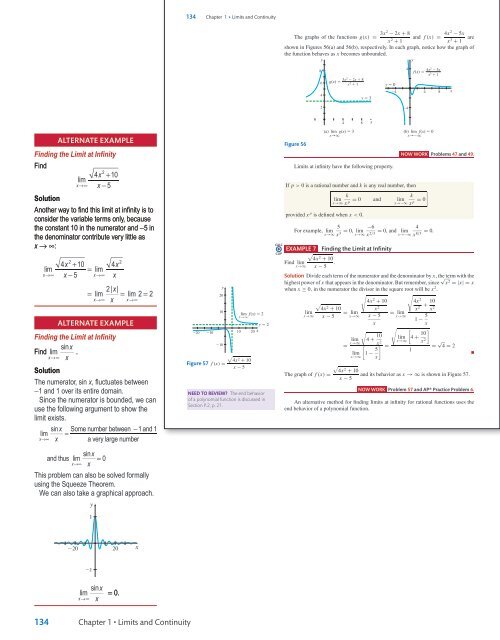Sullivan Microsite DigiSample
Create successful ePaper yourself
Turn your PDF publications into a flip-book with our unique Google optimized e-Paper software.
<strong>Sullivan</strong> AP˙<strong>Sullivan</strong>˙Chapter01 October 8, 2016 17:4<br />
<strong>Sullivan</strong><br />
134 Chapter 1 • Limits and Continuity<br />
The graphs of the functions g(x) = 3x 2 − 2x + 8<br />
and f (x) = 4x 2 − 5x<br />
are<br />
x 2 + 1<br />
x 3 + 1<br />
shown in Figures 56(a) and 56(b), respectively. In each graph, notice how the graph of<br />
the function behaves as x becomes unbounded.<br />
y<br />
y<br />
8<br />
6<br />
4<br />
g(x)<br />
3x 2 2x 8<br />
x 2 1<br />
y 3<br />
y 0<br />
4<br />
4<br />
f(x)<br />
4x 2 5x<br />
x 3 1<br />
4 8<br />
x<br />
2<br />
4<br />
Alternate Example<br />
Finding the Limit at Infinity<br />
Find<br />
x +<br />
lim 4 2<br />
10<br />
x→∞<br />
x − 5<br />
Solution<br />
Another way to find this limit at infinity is to<br />
consider the variable terms only, because<br />
the constant 10 in the numerator and −5 in<br />
the denominator contribute very little as<br />
x → ∞:<br />
x +<br />
x<br />
lim 4 2 10 = lim 4 2<br />
x→∞<br />
x − 5 x→∞<br />
x<br />
x<br />
= lim 2| | = lim 2=<br />
2<br />
x→∞<br />
x x→∞<br />
Alternate Example<br />
Finding the Limit at Infinity<br />
x<br />
Find lim sin .<br />
x→∞<br />
x<br />
Solution<br />
The numerator, sin x, fluctuates between<br />
−1 and 1 over its entire domain.<br />
Since the numerator is bounded, we can<br />
use the following argument to show the<br />
limit exists.<br />
sinx<br />
Some number between −1 and 1<br />
lim ≈<br />
x→∞<br />
x a very large number<br />
x<br />
and thus lim sin = 0<br />
x→∞<br />
x<br />
This problem can also be solved formally<br />
using the Squeeze Theorem.<br />
We can also take a graphical approach.<br />
y<br />
1<br />
20<br />
10<br />
y<br />
20<br />
10<br />
10<br />
Figure 57 f (x) =<br />
lim f (x) 2<br />
x →∞<br />
y 2<br />
10 20 x<br />
√<br />
4x 2 + 10<br />
x − 5<br />
NEED TO REVIEW? The end behavior<br />
of a polynomial function is discussed in<br />
Section P.2, p. 21.<br />
CALC<br />
CLIP<br />
Figure 56<br />
4<br />
8<br />
x<br />
(a) lim g(x) 3 (b) lim<br />
f(x) 0<br />
x→∞ x→ ∞<br />
Limits at infinity have the following property.<br />
If p > 0 is a rational number and k is any real number, then<br />
provided x p is defined when x < 0.<br />
k<br />
lim = 0 and lim<br />
x→∞ x<br />
p<br />
5<br />
−6<br />
For example, lim = 0, lim = 0, and<br />
x→∞ x<br />
3 x→∞ x lim<br />
2/3<br />
EXAMPLE 7 Finding the Limit at Infinity<br />
√<br />
4x<br />
2<br />
+ 10<br />
Find lim<br />
.<br />
x→∞ x − 5<br />
NOW WORK Problems 47 and 49.<br />
x→−∞<br />
x→−∞<br />
k<br />
x = 0 p<br />
4<br />
= 0.<br />
x<br />
8/3<br />
Solution Divide each term of the numerator and the denominator by x, the term with the<br />
highest power of x that appears in the denominator. But remember, since √ x 2 =|x| =x<br />
when x ≥ 0, in the numerator the divisor in the square root will be x 2 .<br />
lim<br />
x→∞<br />
√<br />
4x<br />
2<br />
+ 10<br />
x − 5<br />
= lim<br />
x→∞<br />
√<br />
4x 2 + 10<br />
x 2<br />
x − 5<br />
= lim<br />
x→∞<br />
x<br />
√<br />
√<br />
lim 4 + 10<br />
x→∞<br />
= [ x 2<br />
lim 1 − 5 ] =<br />
x→∞ x<br />
lim<br />
x→∞<br />
√<br />
4x 2<br />
x + 10<br />
2 x 2<br />
1 − 5 x<br />
[<br />
4 + 10 ]<br />
x 2<br />
1<br />
= √ 4 = 2<br />
√<br />
4x<br />
2<br />
+ 10<br />
The graph of f (x) =<br />
x − 5<br />
and its behavior as x →∞is shown in Figure 57.<br />
NOW WORK Problem 57 and AP® Practice Problem 6.<br />
An alternative method for finding limits at infinity for rational functions uses the<br />
end behavior of a polynomial function.<br />
■<br />
220<br />
20<br />
x<br />
21<br />
x→∞<br />
x<br />
x<br />
lim sin<br />
= 0.<br />
134<br />
Chapter 1 • Limits and Continuity<br />
TE_<strong>Sullivan</strong>_Chapter01_PART II.indd 17<br />
11/01/17 9:56 am




